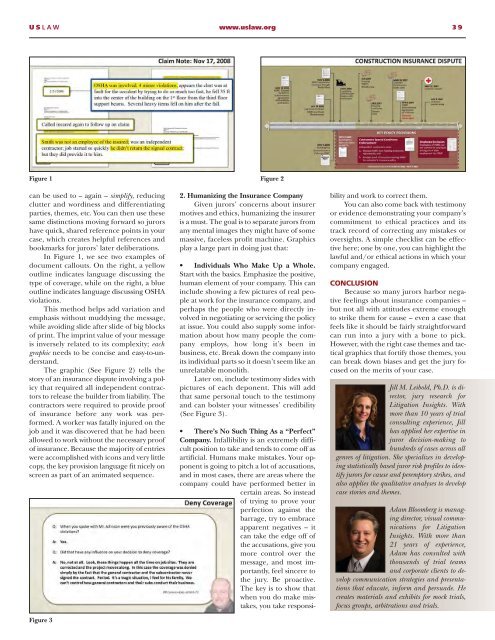CYBER BREACH FALLOUT
2015_Fall_Winter_USLAW-Magazine
2015_Fall_Winter_USLAW-Magazine
You also want an ePaper? Increase the reach of your titles
YUMPU automatically turns print PDFs into web optimized ePapers that Google loves.
USLAW www.uslaw.org 3 9<br />
Figure 1<br />
can be used to – again – simplify, reducing<br />
clutter and wordiness and differentiating<br />
parties, themes, etc. You can then use these<br />
same distinctions moving forward so jurors<br />
have quick, shared reference points in your<br />
case, which creates helpful references and<br />
bookmarks for jurors’ later deliberations.<br />
In Figure 1, we see two examples of<br />
document callouts. On the right, a yellow<br />
outline indicates language discussing the<br />
type of coverage, while on the right, a blue<br />
outline indicates language discussing OSHA<br />
violations.<br />
This method helps add variation and<br />
emphasis without muddying the message,<br />
while avoiding slide after slide of big blocks<br />
of print. The imprint value of your message<br />
is inversely related to its complexity; each<br />
graphic needs to be concise and easy-to-understand.<br />
The graphic (See Figure 2) tells the<br />
story of an insurance dispute involving a policy<br />
that required all independent contractors<br />
to release the builder from liability. The<br />
contractors were required to provide proof<br />
of insurance before any work was performed.<br />
A worker was fatally injured on the<br />
job and it was discovered that he had been<br />
allowed to work without the necessary proof<br />
of insurance. Because the majority of entries<br />
were accomplished with icons and very little<br />
copy, the key provision language fit nicely on<br />
screen as part of an animated sequence.<br />
Figure 3<br />
Figure 2<br />
2. Humanizing the Insurance Company<br />
Given jurors’ concerns about insurer<br />
motives and ethics, humanizing the insurer<br />
is a must. The goal is to separate jurors from<br />
any mental images they might have of some<br />
massive, faceless profit machine. Graphics<br />
play a large part in doing just that:<br />
• Individuals Who Make Up a Whole.<br />
Start with the basics. Emphasize the positive,<br />
human element of your company. This can<br />
include showing a few pictures of real people<br />
at work for the insurance company, and<br />
perhaps the people who were directly involved<br />
in negotiating or servicing the policy<br />
at issue. You could also supply some information<br />
about how many people the company<br />
employs, how long it’s been in<br />
business, etc. Break down the company into<br />
its individual parts so it doesn’t seem like an<br />
unrelatable monolith.<br />
Later on, include testimony slides with<br />
pictures of each deponent. This will add<br />
that same personal touch to the testimony<br />
and can bolster your witnesses’ credibility<br />
(See Figure 3).<br />
• There’s No Such Thing As a “Perfect”<br />
Company. Infallibility is an extremely difficult<br />
position to take and tends to come off as<br />
artificial. Humans make mistakes. Your opponent<br />
is going to pitch a lot of accusations,<br />
and in most cases, there are areas where the<br />
company could have performed better in<br />
certain areas. So instead<br />
of trying to prove your<br />
perfection against the<br />
barrage, try to embrace<br />
apparent negatives – it<br />
can take the edge off of<br />
the accusations, give you<br />
more control over the<br />
message, and most importantly,<br />
feel sincere to<br />
the jury. Be proactive.<br />
The key is to show that<br />
when you do make mistakes,<br />
you take responsibility<br />
and work to correct them.<br />
You can also come back with testimony<br />
or evidence demonstrating your company’s<br />
commitment to ethical practices and its<br />
track record of correcting any mistakes or<br />
oversights. A simple checklist can be effective<br />
here; one by one, you can highlight the<br />
lawful and/or ethical actions in which your<br />
company engaged.<br />
CONCLUSION<br />
Because so many jurors harbor negative<br />
feelings about insurance companies –<br />
but not all with attitudes extreme enough<br />
to strike them for cause – even a case that<br />
feels like it should be fairly straightforward<br />
can run into a jury with a bone to pick.<br />
However, with the right case themes and tactical<br />
graphics that fortify those themes, you<br />
can break down biases and get the jury focused<br />
on the merits of your case.<br />
Jill M. Leibold, Ph.D. is director,<br />
jury research for<br />
Litigation Insights. With<br />
more than 10 years of trial<br />
consulting experience, Jill<br />
has applied her expertise in<br />
juror decision-making to<br />
hundreds of cases across all<br />
genres of litigation. She specializes in developing<br />
statistically based juror risk profiles to identify<br />
jurors for cause and peremptory strikes, and<br />
also applies the qualitative analyses to develop<br />
case stories and themes.<br />
Adam Bloomberg is managing<br />
director, visual communications<br />
for Litigation<br />
Insights. With more than<br />
21 years of experience,<br />
Adam has consulted with<br />
thousands of trial teams<br />
and corporate clients to develop<br />
communication strategies and presentations<br />
that educate, inform and persuade. He<br />
creates materials and exhibits for mock trials,<br />
focus groups, arbitrations and trials.


